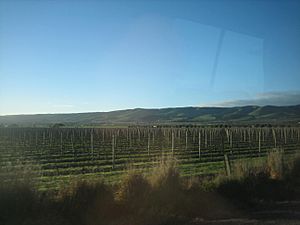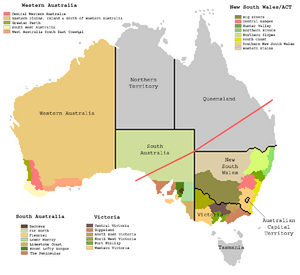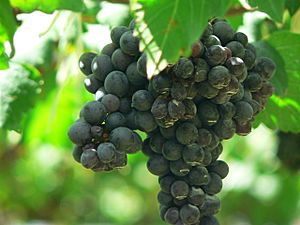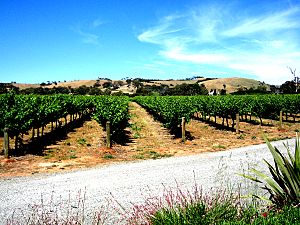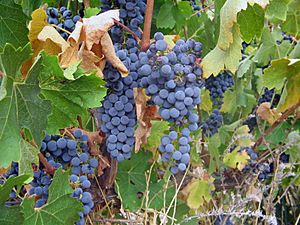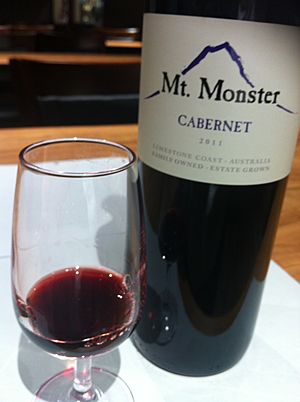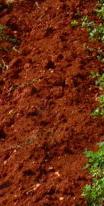South Australian wine facts for kids
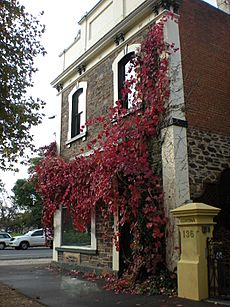
The South Australian wine industry makes more than half of all the wine produced in Australia. South Australia has many different types of land and weather. This allows the state to grow a wide range of grape varieties. For example, they grow Riesling grapes that like cool weather in the Clare Valley wine region. They also grow Shiraz grapes that make strong, full-bodied wines in the Barossa Valley.
Some of Australia's most famous wines, like Penfolds Grange and Jacob's Creek, come from South Australia. Other well-known brands like Yalumba and Henschke Hill of Grace are also made here. Many wines made in large quantities, often sold in boxes, are also produced in this state.
Just like with most farming in Australia, giving water to the plants (called irrigation) is very important for the South Australian wine industry to do well.
Contents
History of Wine in South Australia
The first time someone planted grapevines in South Australia was in 1836. A settler named John Barton Hack planted them in Chichester Gardens, North Adelaide.
In 1838, George Stevenson planted a vineyard in Adelaide. He might have been making wine as early as 1841. Later, as cities grew, Hack's original vines were moved. They were replanted in a new vineyard at Echunga Springs near Mount Barker. In 1843, he sent a box of wine from this vineyard to Queen Victoria. This was the first Australian wine to reach the Queen!
Dr. Christopher Rawson Penfold started his medical practice at a place called "The Grange" in Magill in 1844. He planted grape cuttings from southern France that he had brought with him when he moved to Australia.
Climate and Land
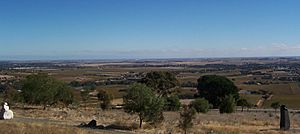
South Australia is in the middle of southern Australia. It shares borders with four other states: Western Australia to the west, Queensland to the northeast, New South Wales to the east, and Victoria to the southeast. The Northern Territory is to the north, and the Great Australian Bight forms the southern coast.
The weather in South Australia changes a lot. Inland areas like the Riverland are very hot. But as you get closer to the coast, like in the Adelaide Hills, it gets cooler. There isn't much rain each year across the region. This means farmers need to use irrigation to help their vines grow during dry periods.
Grapevines are grown at different heights. Some are in low valleys like the Barossa and Riverland. Others are high up, about 600 meters (1,970 feet), in vineyards at Pewsey Vale in the Eden Valley. The soil types are also very different. They include the red terra rossa soil in the Coonawarra area. There are also soils made of limestone and marl in Adelaide and Riverland. The Barossa has sandy, clay loam soils.
Wine Zones and Regions
Since the 1960s, Australia has used a special system for labeling wines. It's called the Australian Geographical Indication (AGI). This system shows where the grapes come from. For a wine to use a region's name on its label, at least 85% of the grapes must come from that region. In the late 1990s, clearer borders were set up. Australia was divided into zones, regions, and subregions.
Adelaide Super Zone
In South Australia, there's an extra type of area called a super zone. This is a group of zones that are next to each other. As of 2014, there is only one super zone: the Adelaide region. It includes the Barossa, Fleurieu, and Mount Lofty Ranges zones. The Adelaide super zone was officially recognized on December 27, 1996.
Barossa Zone
The Barossa zone is just northeast of the Adelaide city area.
- The Barossa Valley wine region is one of Australia's oldest and most famous places for making high-quality wine. It's especially known for its Shiraz wines. The weather here is very hot and dry for a wine-growing area. Most white wine grapes, like Chardonnay, Riesling, and Semillon, are planted on higher hillsides. Here, cool ocean breezes can help them. Recently, the area has also had success with grapes from the Rhône region in France, such as Grenache and Mourvèdre. Because of the hot weather, grapes can get very ripe. Winemakers need to be careful with how long the grape skins stay with the juice. This helps prevent the wines from tasting too strong or bitter.
- The Eden Valley wine region includes the High Eden sub-region. It is known for its rockier, more acidic soil compared to the Barossa Valley next door. This area is higher up, between 400 and 600 meters (1,300-2,000 feet). This means it has colder and wetter weather. The Eden Valley is home to the Hill of Grace vineyard. It has Shiraz vines that are over 140 years old, which are used for the Henschke Hill of Grace wine. The Eden Valley is also famous around the world for its Rieslings, which often have a special taste from the limestone in the soil.
Fleurieu Zone
The Fleurieu zone is south of the Adelaide city area. It is located between the mouth of the River Murray and the Gulf St Vincent. It also includes Kangaroo Island.
- The Currency Creek wine region is on the west side of Lake Alexandrina. It's between towns like Milang and Port Elliot. Chardonnay, Riesling, Sauvignon blanc, and Semillon grapes grow here. The area also makes some good red wines.
- The Kangaroo Island wine region is just off the coast of South Australia. It is known for its wines that are similar to those from Bordeaux in France. Most vineyards are found on ironstone and sandy loam soils near Kingscote.
- The Langhorne Creek wine region is southeast of Adelaide, along the Bremer River. Orlando Wines gets many grapes for its Jacob's Creek brand from this area. This region has also become known for its sweet dessert wines.
- The McLaren Vale wine region is south of Adelaide. It gets about 56 centimeters (22 inches) of rain and has many different soil types, including sand, clay, and limestone. This area produces a wide range of wines. Shiraz, Cabernet Sauvignon, Merlot, Chardonnay, Semillon, and Sauvignon blanc are the most common grapes grown here.
- The Southern Fleurieu region is at the southern end of the Fleurieu Peninsula. The area has sandy loam and gravelly ironstone soil. It supports plantings of Cabernet Sauvignon, Malbec, Riesling, and Viognier. Shiraz, Sauvignon blanc, Merlot, and Primitivo grapes are also grown at Nangkita, in the middle of the Peninsula.
Mount Lofty Ranges Zone
The Mount Lofty Ranges zone is just east of Adelaide. It is north of the Fleurieu zone and both south and north of the Barossa zone.
- The Adelaide Hills is about 14 kilometers (9 miles) from the Gulf St Vincent coast. Winds from the coast help cool this region, making it one of the coolest wine areas in South Australia. This region has two smaller areas: Lenswood and Piccadilly Valley.
- The Adelaide Plains is one of the hottest and flattest wine regions in South Australia. The Magill vineyards, located at the edge of the foothills, were important here. "The Grange," started by Christopher Rawson Penfold, and "Auldana," started by W. P. Auld, once provided grapes for Penfolds' Grange wine. There used to be many vineyards on the Plains south of the Adelaide city centre, but these areas are now covered by Adelaide's growing suburbs.
- The Clare Valley is South Australia's most northern main wine area. It has two sub-regions: Polish Hill River and Watervale. Even though the climate is hot and dry, many vineyards here are not watered. This helps to make fewer grapes, but it makes the flavors in the grapes stronger. The region is known for its Chardonnays, Semillons, and Rieslings. These wines can range from rich and full-bodied to light and delicate.
Far North Zone
The Far North zone is located north of the Clare Valley wine region.
- The Southern Flinders Ranges has had vineyards since the 1890s. However, it has only recently started to get attention from the world of wine. This area is along the Goyder's Line. It gets a good amount of rain and usually harvests grapes earlier than the Clare and Barossa valleys to the south. This area is best for Cabernet Sauvignon, Merlot, and Shiraz grapes.
Limestone Coast Zone
The Limestone Coast zone is in the southeast of the state. It is bordered by the coast to the south, the state of Victoria to the east, and the Lower Murray wine zone to the north.
- The Coonawarra covers an area around the Riddoch Highway, mostly north of the town of Penola. It is known for its Cabernet Sauvignon grapes grown in its special red terra rossa soil. For many years, there were arguments about which vineyards could truly be called "Coonawarra." The soil itself became the deciding factor. Lands with red terra rossa soil were clearly different from the black soil found in other parts of the region. Besides Cabernet, the region has also done well with its Chardonnay, Malbec, Merlot, Petit Verdot, Pinot noir, Riesling, Sauvignon blanc, Semillon, and Shiraz grapes.
- The Mount Benson wine region is in the southeastern part of the state, near the Robe wine region and west of Coonawarra. In the late 1900s, many foreign companies invested here. The wines made here tend to be fruitier and less strong in taste than those from Coonawarra.
- The Mount Gambier wine region is around the city of Mount Gambier. The first grapevines were planted here in 1982. The region was officially recognized as an Australian Geographical Indication in 2010. As of 2014, it has 20 vineyards and eight wineries.
- The Padthaway wine region is a little north of Coonawarra and slightly warmer. It is better known for its white wine production, especially Chardonnay. The wines here are known for having a good balance of natural sourness and fruit flavor.
- The Robe wine region is near Mount Benson in the southeast part of the state, west of Coonawarra.
- The Wrattonbully wine region is between Coonawarra and Padthaway. Its first commercial vineyards were started in 1968. The weather here is similar to Coonawarra, but vineyards in Wrattonbully are usually higher up and have soil that drains water better. The soil includes clay, sand, and loam on top of limestone, with some patches of terra rossa. Cabernet Sauvignon and Shiraz are the most popular grapes planted here.
Lower Murray Zone
The Lower Murray zone is east of the Adelaide superzone. It is bordered by the Limestone Coast zone to the south, the Far North zone to the north, and the border with Victoria to the east.
- The Riverland wine region has a lot of irrigated land. A large part of Australia's wines made in bulk and for boxes are produced here. This is similar to the Riverina region in New South Wales. Cabernet Sauvignon, Chardonnay, Malbec, and Riesling are some of the most planted grapes in the area. The Riverland region also has one of the largest single plantings of Petit Verdot grapes in the world. Kingston Estate has planted 100 hectares (247 acres) of this type of grape.
The Peninsulas Zone
The Peninsulas zone covers the whole Yorke Peninsula. It also includes a part of the Mid North of South Australia, the part of Eyre Peninsula south of a line near Crystal Brook, and the islands off the nearby coast. It is bordered by the Far North zone to its north and the Mount Lofty Ranges zone to its east.
South Eastern Australia Wine Region
The South Eastern Australia wine region covers the area south of a line that runs from Ceduna in western South Australia to the point where the borders of New South Wales, Queensland, and South Australia meet (called Cameron Corner). Then it goes to where the Tropic of Capricorn meets the eastern coast. This region was officially recognized on May 1, 1996.


